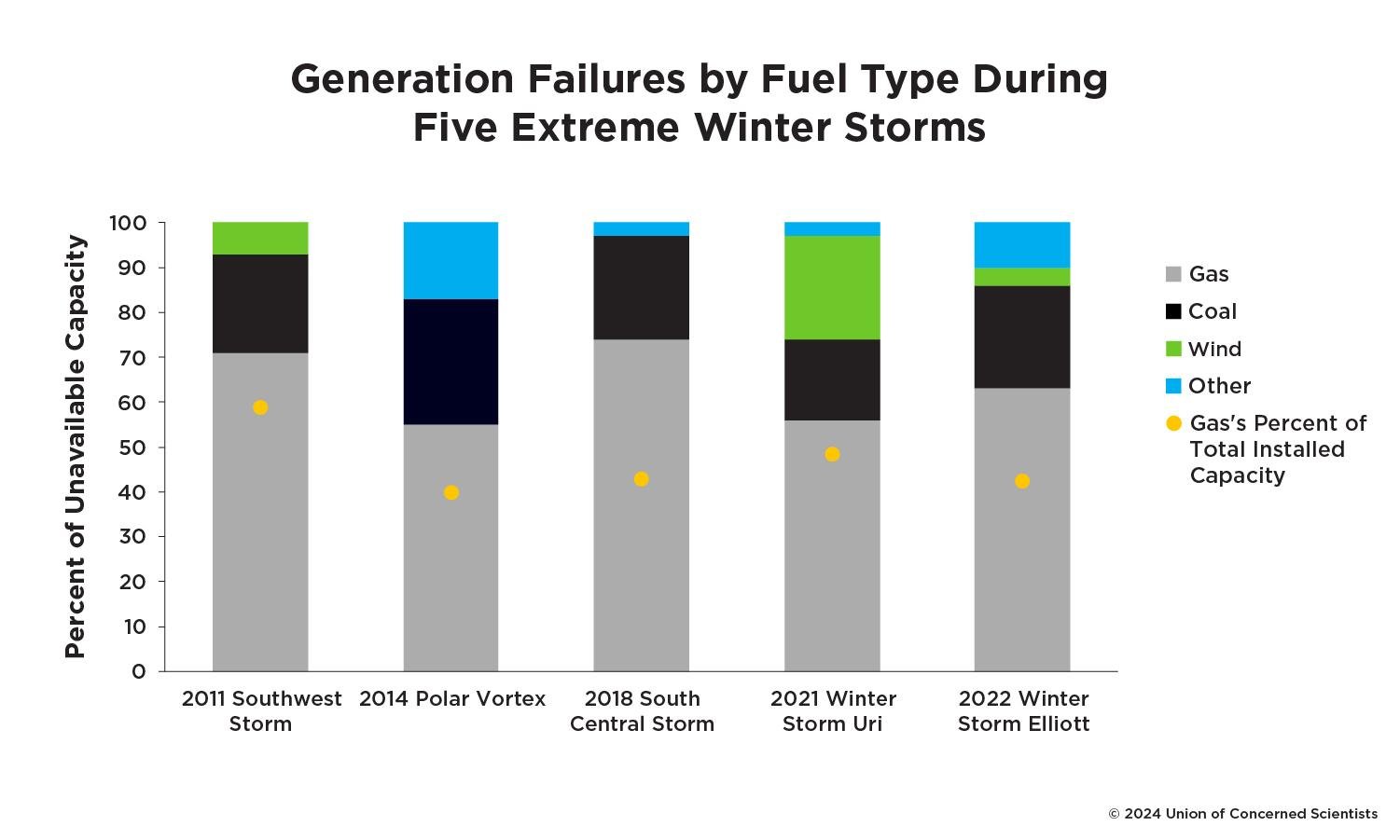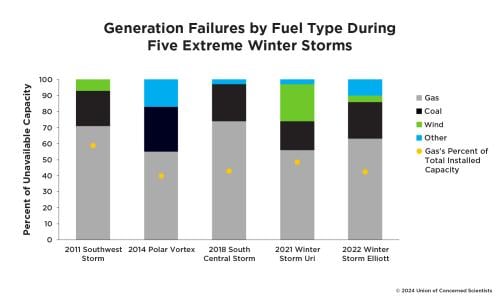The United States is overly reliant on gas plants—and extreme weather is causing them to fail at alarming rates.
We analyzed five recent large-scale power failures in the United States, including the rolling blackouts caused by Winter Storm Uri in 2021. We found that gas plants accounted for most of the failed capacity in all five events.
As the impacts of climate change intensify, extreme weather events are becoming more frequent and more severe, increasing the threat to gas plants and, in turn, to the reliability of the power grid. A number of more modern solutions, including clean energy and battery storage, can help decision makers improve grid reliability, while reducing our reliance on gas.
Gas Malfunction
This is a condensed, online version of the report. For the full text and figures, please download the full report.
The US electricity sector has made significant progress in transitioning to wind, solar, and other clean sources of electricity. However, natural gas–fired power plants ("gas plants") still play a major role on the electric grid, providing 40 percent of electricity generation and accounting for 43 percent of electricity generating capacity. This overreliance on gas plants, coupled with mistaken assumptions about their reliability, is a significant grid vulnerability. Gas plant operations are particularly susceptible to damage and disruptions during extreme weather events, which are becoming more frequent and severe as the climate changes. Gas plant failures in extreme weather threaten grid reliability, and they can lead to rolling blackouts when people most need electricity. Amid a rapidly changing climate and increasingly frequent gas plant failures, we must reassess the role of this resource in ensuring grid reliability.

The Problem: Gas Plant Failures in Extreme Weather
Gas plants are vulnerable to a range of extreme weather events, including heat waves, cold snaps, and droughts, with the most catastrophic failures occurring in winter. Federal officials have identified five winter storms over the past decade that threatened grid reliability. In each case, gas plant failures at a scale far beyond expected levels were the primary contributor to reliability challenges (see Figure 1).
There are two main causes for gas plants being forced to reduce their generation or shut down entirely. One is when gas plants themselves fail, usually when equipment fails in freezing temperatures. Fuel supply problems, the second cause, arise when transportation and production disruptions prevent gas plants from getting enough fuel—for example, when freezing temperatures affect gas production wells.
Such issues have led to widespread gas plant failures, with rolling blackouts on numerous occasions. The most devastating instance took place in 2021 when Winter Storm Uri hit the central United States. At its worst point, the storm knocked nearly a quarter of the affected area's power plant capacity offline. Gas plants accounted for most of the failed capacity. Due in large part to these power plant failures, Texas's grid operator implemented rolling blackouts for more than 70 hours. All told, more than 4.5 million customers in the state lost power, some for as long as four days. Hypothermia caused roughly two-thirds of the 246 deaths in Texas attributed to Uri.
Clean Energy Solutions for Reliability
Utilities can bolster grid reliability by pursuing clean energy solutions on both the supply and demand sides. Supply-side solutions, such as renewables, energy storage, and transmission, can be effective at improving grid reliability, especially when they include a variety of geographically distributed renewable technologies. Demand-side solutions, including energy efficiency, flexible demand, and distributed energy resources, can reduce the need for electricity at times when the need usually increases dramatically, such as for air conditioning during heat waves and heating during cold snaps.
Pursuing clean energy solutions instead of fossil fuels reduces not only global warming emissions but also toxic air pollutants that harm public health, particularly in communities of color where gas plants are disproportionately located. Further, demand-side solutions can reduce the need for new infrastructure and diminish the land-use impacts that come with large-scale projects.
Policy Recommendations
Grid planners, regulators, and policymakers must update the US energy system with solutions that reduce reliance on gas plants, bolster grid reliability, and mitigate the impacts of climate change.
-
The Federal Energy Regulatory Commission (FERC) should order grid operators to consider the risks of widespread gas plant failures during extreme weather when evaluating the reliability of these resources.
-
State regulators should not approve new gas plants except in the extremely limited cases when there are no viable clean energy solutions for grid reliability. Such a determination should rely on improved modeling tools that account for the impact of extreme weather on gas plant performance. No new gas plants should be built in environmental justice communities.
-
FERC, grid operators, and state utility commissions should continue reducing market and regulatory barriers to clean energy resources.
-
Grid operators, along with federal and state regulators, should provide the public with detailed, easily accessible information about power plant outages. This will aid in holding plant owners accountable for preparing for, and responding to, threats to grid reliability.
-
Policymakers should increase regulatory scrutiny of the gas system to reduce the risk of failures in extreme weather—and, in the event that failures do occur, ensure that they do not lead to widespread gas plant outages.
Downloads
Citation
Arbaje, Paul, and Specht, Mark. 2024. Gas Malfunction: Calling into Question the Reliability of Gas Power Plants. Cambridge, MA: Union of Concerned Scientists. https://www.ucsusa.org/resources/gas-malfunction https://doi.org/10.47923/2024.15312

